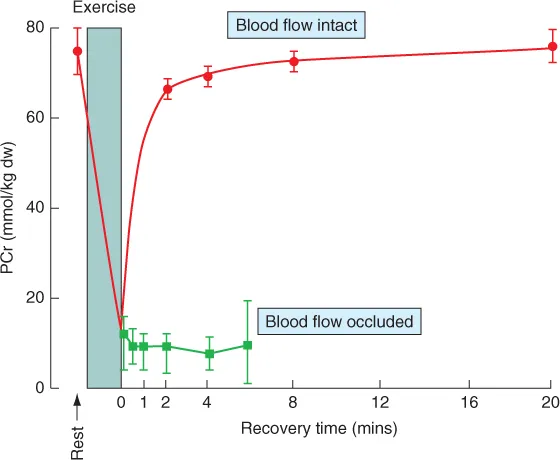![]()
Part One
Basic Muscle Physiology and Energetics
![]()
Chapter 1
Energy Sources for Muscular Activity
Learning outcomes
After studying this chapter, you should be able to:
- outline the key energy sources for exercise;
- distinguish between anaerobic and aerobic sources of energy;
- describe the essential structure of ATP;
- draw and explain the components of the energy continuum;
- describe the role of PCr in ATP synthesis;
- explain how PCr is resynthesized;
- describe the involvement of carbohydrates and fats as energy sources for exercise;
- explain reasons why an athlete is unable to sprint a marathon;
- describe the amounts and sources of energy in the body and their rates of energy formation;
- discuss how amino acids can be used as an energy source during exercise.
This chapter presents a brief overview of the energy sources used by muscles in order to engage in various activities. It is a 'taster' that will (hopefully) encourage you to delve a bit more deeply into the basic biochemistry of the macronutrients which provide energy, as well as to gain an understanding of the likely regulation of the processes which produce energy. From this perspective, this chapter examines the energy-yielding processes from a superficial level in addressing issues of energy for sprinting and for more prolonged events.
Key Words
adenosine diphosphate (ADP)
aerobic
anaerobic
anaerobic alactic
anaerobic glycolytic
anaerobic glycolysis
anaerobic lactic
adenosine triphosphate (ATP)
carbohydrate
CK (creatine kinase)
creatine
dephosphorylation
energy continuum
fatty acid
glycogen
glycogenolysis
glycolysis
lipid
lipolysis
mitochondria
oxidation
PCr (phosphocreatine)
phosphorylation
protein
protein degradation
protein synthesis
1.1 Adenosine Triphosphate: The Energy Currency
In order for our muscles to contract and provide movement, energy is required. Such energy is provided by adenosine triphosphate (ATP) and is the only energy capable of being used for muscle contraction in humans. Figure 1.1 provides the structure of an ATP molecule. As you can see from this diagram, ATP consists of a base (adenine) attached to a sugar (ribose), to which is attached three phosphate molecules. The phosphates are attached by 'high energy' bonds which, when removed, provide energy.
The process is reversible, which means that ATP may be re-formed from adenosine diphosphate (ADP) as long as there is sufficient energy to restore the missing phosphate molecule on to the ADP. The latter can be achieved by phosphocreatine (PCr) or by processes such as anaerobic glycolysis, and aerobic processes.
The stores of ATP in muscle tissue are rather limited, so there is a constant need to resynthesize it for survival, let alone movement. The amount of ATP in a muscle cell amounts to 25 mM/kg dry muscle or about 40–50 g in total, which is sufficient to enable high intense activity for around 2–4 seconds if it is the only useable source of energy available. This is not a great amount—hence the importance of resynthesis of ATP at rates sufficient to enable appropriate levels of exercise to ensue, i.e. fast rates of resynthesis for sprinting and slower rates for prolonged exercise.
1.2 Energy Continuum
The major energy sources for exercise are dependent on the intensity and duration of the activity. Examination of Figure 1.2 highlights that there appears to be three such sources, i.e. PCr, glycolytic and aerobic. These energy-producing processes predominate exercise from 1–10 seconds, 10–60 seconds and beyond 60 seconds respectively.
Another way of expressing the energy continuum is represented in Figure 1.3, which shows the major energy sources for running events of varying distances. Note that short, highly intense sprinting bouts lasting 1–10 seconds use PCr predominantly, while events such as the 400 metres mainly use anaerobic glycolysis, and thereafter aerobic metabolism predominates.
1.3 Energy Supply for Muscle Contraction
ATP is not stored to a great degree in muscle cells. Therefore, once muscle contraction starts, the regeneration of ATP must occur rapidly. There are three primary sources of ATP; these, in order of their utilization, are PCr, anaerobic glycolysis and aerobic processes.
Energy from ATP derives from cleaving the terminal phosphate of the ATP molecule. The resulting molecule is adenosine diphosphate (ADP). Phosphocreatine converts ADP back to ATP by donating its phosphate in the presence of the enzyme creatine kinase (CK), and in turn the PCr forms creatine (Cr), i.e. the dephosphorylated form of PCr.
The reaction of PCr with ADP to form ATP is very rapid, but is short-lived since the cell does not store high amounts of PCr (the muscle concentration of PCr is about 80 mM/kg dry muscle or 120 g in total). However, during short, high-intensity contractions, PCr serves as the major source of energy. This form of energy generation is often called anaerobic alactic, because it neither produces lactic acid nor requires oxygen. It is of paramount importance in sports requiring bursts of speed or power, such as sprints of 1–10 seconds.
Figure 1.4 provides a schematic to show the synthesis of ATP from ADP using PCr at the muscle crossbridge, and also the regeneration of PCr from Cr by ATP at the mitochondria.
Thus, Cr is formed from PCr during intense bouts of exercise, while Cr is re-phosphorylated to PCr by ATP produced in the mitochondria during aerobic recovery. Oxygen is needed for recovery of PCr, as can be seen in Figure 1.5, which clearly demonstrates that recovery of exercise-depleted PCr only happens when the blood supply to the exercising muscle is not occluded, i.e. there is an intact blood supply taking oxygen to the cells. If the blood supply is occluded (e.g. via a tourniquet), then PCr resynthesis fails. As a consequence, you should appreciate the need for a low level (so called active) recovery in between bouts of intense exercise.
The enzyme CK, which regulates PCr activity, exists in a number of forms known as isoforms (this will be dealt with later). Note that not only is there a CK which favours the formation of ATP from PCr, but there is also another form, CK
, which is present at the mitochondria...








